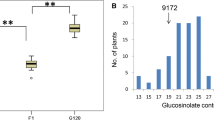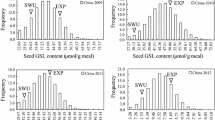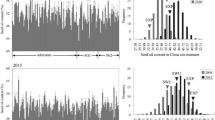Abstract
Breeding of oilseed rape (Brassica napus ssp. napus) has evoked a strong bottleneck selection towards double-low (00) seed quality with zero erucic acid and low seed glucosinolate content. The resulting reduction of genetic variability in elite 00-quality oilseed rape is particularly relevant with regard to the development of genetically diverse heterotic pools for hybrid breeding. In contrast, B. napus genotypes containing high levels of erucic acid and seed glucosinolates (++ quality) represent a comparatively genetically divergent source of germplasm. Seed glucosinolate content is a complex quantitative trait, however, meaning that the introgression of novel germplasm from this gene pool requires recurrent backcrossing to avoid linkage drag for high glucosinolate content. Molecular markers for key low-glucosinolate alleles could potentially improve the selection process. The aim of this study was to identify potentially gene-linked markers for important seed glucosinolate loci via structure-based allele-trait association studies in genetically diverse B. napus genotypes. The analyses included a set of new simple-sequence repeat (SSR) markers whose orthologs in Arabidopsis thaliana are physically closely linked to promising candidate genes for glucosinolate biosynthesis. We found evidence that four genes involved in the biosynthesis of indole, aliphatic and aromatic glucosinolates might be associated with known quantitative trait loci for total seed glucosinolate content in B. napus. Markers linked to homoeologous loci of these genes in the paleopolyploid B. napus genome were found to be associated with a significant effect on the seed glucosinolate content. This example shows the potential of Arabidopsis-Brassica comparative genome analysis for synteny-based identification of gene-linked SSR markers that can potentially be used in marker-assisted selection for an important trait in oilseed rape.



Similar content being viewed by others
References
Aranzana MJ, Kim S, Zhao K, Bakker E, Horton M, Jakob K, Lister C, Molitor J, Shindo C, Tang C, Toomajian C, Traw B, Zheng H, Bergelson J, Dean C, Marjoram P, Nordborg M (2006) Genome-wide association mapping in Arabidopsis identifies previously known flowering time and pathogen resistance genes. PLOS Genet 1:531–539
Bak S, Tax FE, Feldmann KA, Galbraith DW, Feyereisen R (2001) CYP83B1, a cytochrome P450 at the metabolic branch point in auxin and indole glucosinolate biosynthesis in Arabidopsis. Plant Cell 13:101–111
Balasubramanian S, Sureshkumar S, Agrawal M, Michael TP, Wessinger C, Maloof JN, Clark R, Warthmann N, Chory J, Weigel D (2006) The PHYTOCHROME C photoreceptor gene mediates natural variation in flowering and growth responses of Arabidopsis thaliana. Nat Genet 38:711–715
Bao JS, Corke H, Sun M (2006) Nucleotide diversity in starch synthase IIa and validation of single nucleotide polymorphisms in relation to starch gelatinization temperature and other physicochemical properties in rice (Oryza sativa L.). Theor Appl Genet 113:1171–1183
Basunanda P, Spiller TH, Hasan M, Gehringer A, Schondelmaier J, Lühs W, Friedt W, Snowdon RJ (2007) Marker-assisted increase of genetic diversity in a double-low seed quality winter oilseed rape genetic background. Plant Breed 126:581–587
Berg ES, Olaisen B (1994) Hybrid PCR sequencing—sequencing of PCR products using a universal primer. Biotechniques 17:896–901
Breseghello F, Sorrells ME (2006) Association analysis as a strategy for improvement of quantitative traits in plants. Crop Sci 46:1323–1330
Celenza JL, Quiel JA, Smolen GA, Merrikh H, Silvestro AR, Normanly J, Bender J (2005) The Arabidopsis ATR1 Myb transcription factor controls indolic glucosinolate homeostasis. Plant Physiol 137:253–262
Doyle JJ, Doyle JL (1990) Isolation of plant DNA from fresh tissue. Focus 12:13–15
Ehrenreich IM, Stafford PA, Purugganan MD (2007) The genetic architecture of shoot branching in Arabidopsis thaliana: A comparative assessment of candidate gene associations vs. quantitative trait locus mapping. Genetics 176:1223–1236
Flint-Garcia SA, Thornsberry JM, Buckler ES IV (2003) Structure of linkage disequilibrium in plants. Annu Rev Plant Biol 54:357–374
Gebhardt C, Ballvora A, Walkemeier B, Oberhagemann P, Schüler K (2004) Assessing genetic potential in germplasm collections of crop plants by marker-trait association: a case study for potatoes with quantitative variation of resistance to late blight and maturity type. Mol Breed 13:93–102
Hagenblad J, Nordborg M (2002) Sequence variation and haplotype structure surrounding the flowering time locus Fr1 in Arabidopsis thaliana. Genetics 161:289–298
Hansen CH, Du L, Naur P, Olsen CE, Axelsen KB, Hick AJ, Pickett JA, Halkier BA (2001) CYP83B1 is the oxime-metabolizing enzyme in the glucosinolate pathway in Arabidopsis. J Biol Chem 276:24790–24796
Hasan M, Seyis F, Badani AG, Pons-Kuhnemann J, Lühs W, Friedt W, Snowdon RJ (2006) Analysis of genetic diversity in the Brassica napus L. gene pool using SSR markers. Genet Resour Crop Evol 53:793–802
Hoecker U, Toledo-Ortiz G, Bender J, Quail PH (2004) The photomorphogenesis-related mutant red1 is defective in CYP83B1, a red light-induced gene encoding a cytochrome P450 required for normal auxin homeostasis. Planta 219:195–200
Howell PM, Sharpe AG, Lydiate DJ (2003) Homoeologous loci control the accumulation of seed glucosinolates in oilseed rape (Brassica napus). Genome 46:454–460
Iwata H, Uga Y, Yoshioka Y, Ebana K, Hayashi T (2007) Bayesian association mapping of multiple quantitative trait loci and its application to the analysis of genetic variation among Oryza sativa L. germplasms. Theor Appl Genet 114:1437–1449
Kimber DS, McGregor DI (1995) The species and their origin, cultivation and world production. In: Kimber D, McGregor DI (eds) Brassica oilseeds: production and utilization. CABI Publishing, Wallingford, pp 1–9
Kroymann J, Textor S, Tokuhisa JG, Falk KL, Bartram S, Gershenzon J, Mitchell-Olds T (2001) A gene controlling variation in Arabidopsis thaliana glucosinolate composition is part of the methionine chain elongation pathway. Plant Physiol 127:1077–1088
Levy M, Wang Q, Kaspi R, Parrella MP, Abel S (2005) Arabidopsis IQD1, a novel calmodulin-binding nuclear protein, stimulates glucosinolate accumulation and plant defence. Plant J 43:79–96
Lühs W, Seyis F, Frauen M, Busch H, Frese L, Willner E, Friedt W, Gustafsson M, Poulsen G (2003) Development and evaluation of a Brassica napus core collection. In: Knüpffer H, Ochsmann J (eds) Rudolf Mansfeld and Plant Genetic Resources. Proceedings of a symposium dedicated to the 100th birthday of Rudolf Mansfeld, Gatersleben, Germany, 8–9 October 2001. Schriften zu Genetischen Ressourcen 19. ZADI/IBV, Bonn, pp 284–289 (http://www.genres.de/infos/rei-bd22.htm)
Marchini J, Cardon LR, Phillips MS, Donnelly P (2004) The effects of human population structure on large genetic association studies. Nat Genet 36:512–517
Mithen RF, Dekker M, Verkerk R, Rabot S, Johnson IT (2000) The nutritional significance, biosynthesis and bioavailability of glucosinolates in human foods. J Sci Food Agric 80:967–984
Oesterberg MK, Shavorskaya O, Lascoux M, Lagercrantz U (2002) Naturally occurring indel variation in the Brassica nigra COL1 gene is associated with variation in flowering time. Genetics 161:299–306
Parkin IA, Gulden SM, Sharpe AG, Lukens L, Trick M, Osborn TC, Lydiate DJ (2005) Segmental structure of the Brassica napus genome based on comparative analysis with Arabidopsis thaliana. Genetics 171:765–781
Peleman JD, van der Voort JR (2003) Breeding by design. Trends Plant Sci 8:330–334
Poulsen G, Busch H, Frauen M, Frese L, Friedt W, Gustafsson M, Ottosson F, Seyis F, Stemann G, Ulber B, Willner E, Lühs W (2004) The European Brassica napus core collection—characterisation, evaluation and establishment. Cruciferae Newsl 25:115–116
Pritchard JK, Stephens M, Donnelly P (2000) Inference of population structure using multilocus genotype data. Genetics 155:945–959
Rask L, Andréasson E, Ekbom B, Eriksson S, Pontoppidan B, Meijer J (2000) Myrosinase: gene family evolution and herbivory defense in Brassicaceae. Plant Mol Biol 42:93–113
Röbbelen G (1975) Totale Sortenumstellung bei Körnerraps. Bericht über die Arbeitstagung der Arbeitsgemeinschaft der Saatzuchtleiter, Gumpenstein. Arbeitsgemeinschaft der Saatzuchtleiter, Austria, pp 119–146
Rygulla W, Snowdon RJ, Friedt W, Happstadius I, Cheung WY, Chen D (2008) Identification of quantitative trait loci for resistance against Verticillium longisporum in oilseed rape (Brassica napus). Phytopathology 98:215–221
Schuster W (1987) Die Entwicklung des Anbaues und der Züchtung von Ölpflanzen in Mitteleuropa. Fat Sci Technol 89:15–27
Seyis F, Snowdon RJ, Lühs W, Friedt W (2003) Molecular characterisation of novel resynthesised rapeseed (Brassica napus L.) lines and analysis of their genetic diversity in comparison to spring rapeseed cultivars. Plant Breed 122:473–478
Sharpe AG, Lydiate DJ (2003) Mapping the mosaic of ancestral genotypes in a cultivar of oilseed rape (Brassica napus) selected via pedigree breeding. Genome 46:461–468
Snowdon RJ, Friedt W (2004) Molecular markers in Brassica oilseed breeding: current status and future possibilities. Plant Breed 123:1–8
Textor S, Bartram S, Kroymann J, Falk KL, Hick A, Pickett J.A, Gershenzon J (2004) Biosynthesis of methionine-derived glucosinolates in Arabidopsis thaliana: recombinant expression and characterization of methylthioalkylmalate synthase, the condensing enzyme of the chain elongation cycle. Planta 218:1026–1035
Thompson KF (1983) Breeding winter oilseed rapeseed Brassica napus. Adv Appl Biol 7:1–104
Thornsberry JM, Goodman MM, Doebley J, Kresovich S, Nielsen D, Buckler ES IV (2001) Dwarf8 polymorphisms associate with variation in flowering time. Nat Genet 28:286–289
Uzunova M, Ecke W, Weissleder K, Röbbelen G (1995) Mapping the genome of rapeseed (Brassica napus L.). I. Construction of an RFLP linkage map and localization of QTLs for seed glucosinolate content. Theor Appl Genet 90:194–204
Walker KC, Booth EJ (2001) Agricultural aspects of rape and other Brassica products. Eur J Lipid Sci Technol 103:441–446
Whitt SR, Buckler ES IV (2003) Using natural allelic diversity to evaluate gene function. In: Grotewald E (ed) Plant functional genomics: methods and protocols. Humana Press, New York, pp 123–140
Wilson LM, Whitt SR, Ibáñez AM, Rocheford TR, Goodman MM, Buckler ES (2004) Dissection of maize kernel composition and starch production by candidate gene association. Plant Cell 16:2719–2733
Wittstock U, Halkier BA (2000) Cytochrome P450 CYP79A2 from Arabidopsis thaliana L. catalyzes the conversion of l-phenylalanine to phenylacetaldoxime in the biosynthesis of benzylglucosinolate. J Biol Chem 275:14659–14666
Wittstock U, Halkier BA (2002) Glucosinolate research in the Arabidopsis era. Trends Plant Sci 7:263–270
Xu XY, Bai GH, Carver BF, Shaner GE (2005) Mapping of QTLs prolonging the latent period of Puccinia triticina infection in wheat. Theor Appl Genet 110:244–251
Yu J, Pressior G, Briggs WH, Bi IV, Yamasaki M, Doebley JF, McMullen MD, Gaut BS, Nielsen DM, Holland JB, Kresovich S, Buckler ES (2006) A unified mixed-model method for association mapping that accounts for multiple levels of relatedness. Nat Genet 38:203–208
Zhao J, Meng J (2003) Detection of loci controlling seed glucosinolate content and their association with Sclerotinia resistance in Brassica napus. Plant Breed 122:19–23
Acknowledgments
The authors thank Fatih Seyis, Wilfried Lühs, and KWS Saat AG for providing seed material for this study. We also thank Liane Renno and Petra Degen for valuable technical assistance. Some of the SSR primers were kindly provided by Wolfgang Ecke, University of Göttingen, and Jörg Schondelmaier, SaatenUnion Resistenzlabor GmbH, Leopoldshöhe. Genome-wide SSR data for the 46 winter rapeseed genotypes genotypes was made available by KWS Saat, SaatenUnion Resistenzlabor and SW Seed GmbH as part of the BMBF-funded project GABI-BRIDGE. We thank two anonymous reviewers and the subject editor for constructive comments that led to considerable improvements in the manuscript.
Author information
Authors and Affiliations
Corresponding author
Additional information
Communicated by M. Sillanpää.
Electronic supplementary material
Below is the link to the electronic supplementary material.
122_2008_733_MOESM1_ESM.xls
Supplementary Table 1. PCR primers for twelve new simple sequence repeat (SSR) sequences whose othologs in Arabidopsis thaliana are closely physically linked to glucosinolate biosynthesis genes. Five of the primer combinations amplify SSR loci in Brassica napus that were found to be significantly associated (P ≤ 0.05) with total seed glucosinolate content. (XLS 15 kb)
122_2008_733_MOESM2_ESM.xls
Supplementary Table 2. Allelic data for SSR markers showing significant allele-trait association to total seed glucosinolate content in two sets of genetically diverse B. napus genotypes: (a) 94 genetically diverse gene bank accessions; (b) 46 genetically diverse winter rapeseed cultivars and breeding lines. Cells with a green background indicate the presence of the marker allele in the particular genotype. Markers are sorted from left (low) to right (high) based on the mean total seed glucosinolate content of all genotypes containing the given marker allele, while each of the two sets of genotypes is also sorted in ascending order according to the mean total seed glucosinolate content. Hence the green cells in the above left corner of each table represent marker alleles associated with very low glucosinolate content, while the green cells at the bottom right of each table represent marker alleles associated with very high glucosinolate content. (XLS 95 kb)
Rights and permissions
About this article
Cite this article
Hasan, M., Friedt, W., Pons-Kühnemann, J. et al. Association of gene-linked SSR markers to seed glucosinolate content in oilseed rape (Brassica napus ssp. napus). Theor Appl Genet 116, 1035–1049 (2008). https://doi.org/10.1007/s00122-008-0733-3
Received:
Accepted:
Published:
Issue Date:
DOI: https://doi.org/10.1007/s00122-008-0733-3




